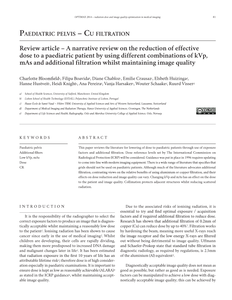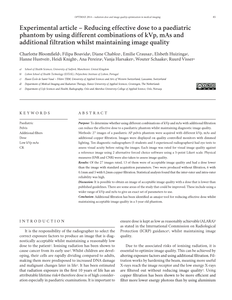Within paediatric palliative care, it is essential for families and providers to have open, equal, and trusting relationships. In practice, however, building relationships can be challenging. Investing in better understanding the differences in each other's frames of reference and underlying values seems important. Wonder Lab practices provide a space to explore these differences by focusing together on life phenomena in curious and Socratic ways. Wonder Labs were organised with parents, healthcare professionals, and students involved in Dutch paediatric palliative care. The aim of this study was to develop an understanding of how participants experienced participating in Wonder Labs. We conducted twenty in-depth interviews with Wonder Lab participants and used inductive thematic analysis for data interpretation. Five themes were identified: Slowing down, Appreciating stories, Becoming vulnerable, Opening up and diving in, and Reframing perspectives. Participating in Wonder Labs allowed mothers, healthcare professionals, and students to contribute to deepening experiences and gain an expanded understanding of what is at play in caring for children with life-limiting and life-threatening conditions. Through working in pluralised groups, frames of reference and understandings complemented each other and could change. Participants often adopted a more open attitude towards others involved in care after participating and adapted day-to-day practices. Deliberating within paediatric palliative care on sensitive issues and their underlying personal and professional beliefs and values must be part of working together, without specific care situations being the catalyst. This may foster the mutual understanding needed in searching for quality of life, death, and bereavement.
MULTIFILE

The six-minute walk test (6MWT) is a self-paced, submaximal exercise test used to assess functional exercise capacity in patients with chronic diseases (Chang 2006, Solway et al 2001). It has been used widely in adults, and is being utilised increasingly in paediatric populations; it has been used as an estimate of physical fitness in, for example, children with severe cardiopulmonary disease, cystic fibrosis, and juvenile idiopathic arthritis (Hassan et al 2010).
DOCUMENT

Objectives: Children have a greater risk from radiation, per unit dose, due to increased radiosensitivity and longer life expectancies. It is of paramount importance to reduce the radiation dose received by children.This research concerns chest CT examinations on paediatric patients. The purpose of this study was to compare the image quality and the dose received from imaging with images reconstructed with filtered back projection (FBP) and five strengths of Sinogram-Affirmed Iterative Reconstruction (SAFIRE).Methods: Using a multi-slice CT scanner, six series of images were taken of a paediatric phantom. Two kVp values (80 and 110), 3 mAs values (25, 50 and 100) and 2 slice thicknesses (1 mm and 3 mm) were used. All images were reconstructed with FBP and five strengths of SAFIRE. Ten observers evaluatedvisual image quality. Dose was measured using CT-Expo.Results: FBP required a higher dose than all SAFIRE strengths to obtain the same image quality for sharpness and noise. For sharpness and contrast image quality ratings of 4, FBP required doses of 6.4 and 6.8 mSv respectively. SAFIRE 5 required doses of 3.4 and 4.3 mSv respectively. Clinical acceptance rate was improved by the higher voltage (110 kV) for all images in comparison to 80 kV, which required a higher dose for acceptable image quality. 3 mm images were typically better quality than 1 mm images.Conclusion: SAFIRE 5 was optimal for dose reduction and image quality
DOCUMENT

This paper reviews the literature for lowering of dose to paediatric patients through use of exposure factors and additional filtration. Dose reference levels set by The International Commission on Radiological Protection (ICRP) will be considered. Guidance was put in place in 1996 requires updatingto come into line with modern imaging equipment. There is a wide range of literature that specifies that grids should not be used on paediatric patients. Although much of the literature advocates additional filtration, contrasting views on the relative benefits of using aluminium or copper filtration, and theireffects on dose reduction and image quality can vary. Changing kVp and mAs has an effect on the dose to the patient and image quality. Collimation protects adjacent structures whilst reducing scattered radiation.
DOCUMENT

Background: Computed tomography (CT) is one of the most used modalities for diagnostics in paediatric populations, which is a concern as it also delivers a high patient dose. Research has focused on developing computer algorithms that provide better image quality at lower dose. The iterative reconstruction algorithm Sinogram-Affirmed Iterative Reconstruction (SAFIRE) was introduced as a new technique that reduces noise to increase image quality.Purpose: The aim of this study is to compare SAFIRE with the current gold standard, Filtered Back Projection (FBP), and assess whether SAFIRE alone permits a reduction in dose while maintaining image quality in paediatric head CT.Methods: Images were collected using a paediatric head phantom using a SIEMENS SOMATOMPERSPECTIVE 128 modulated acquisition. 54 images were reconstructed using FBP and 5 different strengths of SAFIRE. Objective measures of image quality were determined by measuring SNR and CNR. Visual measures of image quality were determined by 17 observers with different radiographic experiences. Images were randomized and displayed using 2AFC; observers scored the images answering 5 questions using a Likert scale.Results: At different dose levels, SAFIRE significantly increased SNR (up to 54%) in the acquired images compared to FBP at 80kVp (5.2-8.4), 110kVp (8.2-12.3), 130kVp (8.8-13.1). Visual image quality was higher with increasing SAFIRE strength. The highest image quality was scored with SAFIRE level 3and higher.Conclusion: The SAFIRE algorithm is suitable for image noise reduction in paediatric head CT. Our data demonstrates that SAFIRE enhances SNR while reducing noise with a possible reduction of dose of 68%.
DOCUMENT

Purpose: To determine whether using different combinations of kVp and mAs with additional filtration can reduce the effective dose to a paediatric phantom whilst maintaining diagnostic image quality.Methods: 27 images of a paediatric AP pelvis phantom were acquired with different kVp, mAs and additional copper filtration. Images were displayed on quality controlled monitors with dimmed lighting. Ten diagnostic radiographers (5 students and 5 experienced radiographers) had eye tests to assess visual acuity before rating the images. Each image was rated for visual image quality against a reference image using 2 alternative forced choice software using a 5-point Likert scale. Physical measures (SNR and CNR) were also taken to assess image quality.Results: Of the 27 images rated, 13 of them were of acceptable image quality and had a dose lower than the image with standard acquisition parameters. Two were produced without filtration, 6 with 0.1mm and 5 with 0.2mm copper filtration. Statistical analysis found that the inter-rater and intra-raterreliability was high.Discussion: It is possible to obtain an image of acceptable image quality with a dose that is lower than published guidelines. There are some areas of the study that could be improved. These include using a wider range of kVp and mAs to give an exact set of parameters to use.Conclusion: Additional filtration has been identified as amajor tool for reducing effective dose whilst maintaining acceptable image quality in a 5 year old phantom.
DOCUMENT

Introduction: The purpose of this review is to gather and analyse current research publications to evaluate Sinogram-Affirmed Iterative Reconstruction (SAFIRE). The aim of this review is to investigate whether this algorithm is capable of reducing the dose delivered during CT imaging while maintainingimage quality. Recent research shows that children have a greater risk per unit dose due to increased radiosensitivity and longer life expectancies, which means it is particularly important to reduce the radiation dose received by children.Discussion: Recent publications suggest that SAFIRE is capable of reducing image noise in CT images, thereby enabling the potential to reduce dose. Some publications suggest a decrease in dose, by up to 64% compared to filtered back projection, can be accomplished without a change in image quality.However, literature suggests that using a higher SAFIRE strength may alter the image texture, creating an overly ‘smoothed’ image that lacks contrast. Some literature reports SAFIRE gives decreased low contrast detectability as well as spatial resolution. Publications tend to agree that SAFIRE strength threeis optimal for an acceptable level of visual image quality, but more research is required. The importance of creating a balance between dose reduction and image quality is stressed. In this literature review most of the publications were completed using adults or phantoms, and a distinct lack of literature forpaediatric patients is noted.Conclusion: It is necessary to find an optimal way to balance dose reduction and image quality. More research relating to SAFIRE and paediatric patients is required to fully investigate dose reduction potential in this population, for a range of different SAFIRE strengths.
DOCUMENT

This thesis focuses on topics such as preterm birth, variation in gross motor development, factors that influence (premature) infant gross motor development, and parental beliefs and practices. By gaining insight into these topics, this thesis aims to contribute to clinical decision-making of paediatric physiotherapists together with parents, and with that shape early intervention.
DOCUMENT

OBJECTIVES: To compare low contrast detail (LCD) detectability and radiation dose for routine paediatric chest X-ray (CXR) imaging protocols among various hospitals.METHODS: CDRAD 2.0 phantom and medical grade polymethyl methacrylate (PMMA) slabs were used to simulate the chest region of four different paediatric age groups. Radiographic acquisitions were undertaken on 17 X-ray machines located in eight hospitals using their existing CXR protocols. LCD detectability represented by image quality figure inverse (IQF inv) was measured physically using the CDRAD analyser software. Incident air kerma (IAK) measurements were obtained using a solid-state dosimeter. RESULTS: The range of IQF inv, between and within the hospitals, was 1.40-4.44 and 1.52-2.18, respectively for neonates; 0.96-4.73 and 2.33-4.73 for a 1-year old; 0.87-1.81 and 0.98-1.46 for a 5-year old and 0.90-2.39 and 1.27-2.39 for a 10-year old. The range of IAK, between and within the hospitals, was 8.56-52.62 μGy and 21.79-52.62 μGy, respectively for neonates; 5.44-82.82 μGy and 36.78-82.82 μGy for a 1-year old; 10.97-59.22 μGy and 11.75-52.94 μGy for a 5-year old and 13.97-100.77 μGy and 35.72-100.77 μGy for a 10-year old. CONCLUSIONS: Results show considerable variation, between and within hospitals, in the LCD detectability and IAK. Further radiation dose optimisation for the four paediatric age groups, especially in hospitals /X-ray rooms with low LCD detectability and high IAK, are required.
DOCUMENT
The aim of the present study was to establish the efficacy in terms of morbidity and health-related quality of life (HRQoL) of a group asthma education-exercise programme to children with low (below 10th percentile value) quality-of-life scores. A controlled, randomised, open, clinical trial was conducted. In total, 36 out of 53 unhappy children, among 204 (68%) respondents, treated in four paediatric practices, enrolled (mean age 10 yrs; range: 8-12 yrs), after random allocation in control and intervention groups (child, parent, teacher). Measurements were taken at baseline (T0) and after 3, 6 (T6) and 9 months (T9; intervention group only at 9 months). All but four controls completed the study. From T0-T6, changes (Delta) in HRQoL were clinically important and significantly greater in the intervention group than in the control group, both for generic HRQoL (effect size (ES) 0.95; Delta 16%+/-12% versus -1+/-4%) and for asthma-specific HRQoL (ES 0.58; Delta 15%+/-17% versus 1.5+/-14%). T9 measurements were consistent with T6 findings. Changes in sick days (ES 0.78), oral prednisone courses (ES 0.71) and doctor visits (ES 0.74) over a 6-month period were greater in the intervention group than in the control group. Changes could not be ascribed to change in lung function or medication. In unhappy children, quality of life and morbidity may improve with a low intensity asthma education-exercise programme, even without gains in pulmonary function or exercise tolerance.
DOCUMENT